Each child follows an individualised path of development, which might involve concentrating on a single skill or developmental milestone, or even juggling multiple aspects simultaneously. What’s crucial to recognise is that each child advances at their own rhythm. Being delayed in one area doesn’t automatically signify a requirement for additional assistance.
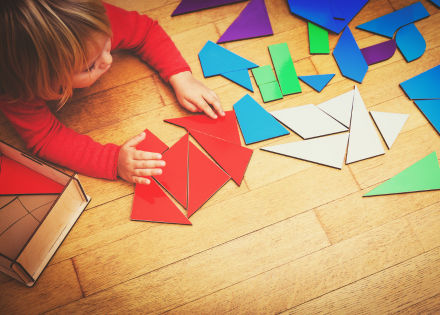
If you have any concerns about your child’s development, you can speak to your GP, pediatrician or community nurse for their professional advice.
In this article we cover, developmental milestones for the following age groups:
- Milestones Birth to 4 months
- Milestones 4 – 8 Months
- Milestones 8 – 12 Months
- Milestones for 1 – 2 Year Old’s
- Milestones for 2 – 3 Year Old’s
- Milestones for 3 – 5 Year Old’s
The Early Years Learning Framework (EYLF)
In this article, we’ll delve into the Australian Government’s Early Years Learning Framework (EYLF) – a valuable resource that provides insights into accomplishing developmental milestones.
According to EYLF, there are 5 developmental areas for meeting milestones, they are:
Physical – the coordination of movement, such as picking up an object, sitting up, crawling, or walking.
Social – how the child interacts with people around them, including how they play and acknowledge others
Emotional – displaying emotions to have their needs met and ability to create meaningful connections
Cognitive – learning new skills and transferring what they have learned from one context to another
Language – verbal and non-verbal communication skills from babies crying when they need something, to coos and gurgles when content
It’s important to emphasise that this guidance is not absolute; not all children will conform precisely to the suggested timelines for achieving every milestone.
“Children’s learning is ongoing, and each child will progress towards the outcomes in different and equally meaningful ways. Learning is not always predictable and linear. Educators plan with each child and the outcomes in mind” [1].
According to the American Academy of Pediatrics, when assessing the development of a child the clinician must appreciate the total developmental progression of a child while also understanding the patterns of development expected within individual developmental streams [2].
While a child might not have started walking, they could display advanced verbal and cognitive abilities. Yet, it’s important to note that this alone doesn’t necessarily indicate a developmental delay. Examining the developmental timeline of other family members can be informative. For instance, if the child’s cousins began walking around 18 months as opposed to 12 months, it provides context to determine what falls within the typical range of development for that specific child.
Milestones Birth to 4 months
From birth to 4 months, babies undergo remarkable changes in various aspects of their development, including starting to smile, grasp at toys and responding to their caregivers’ attention.
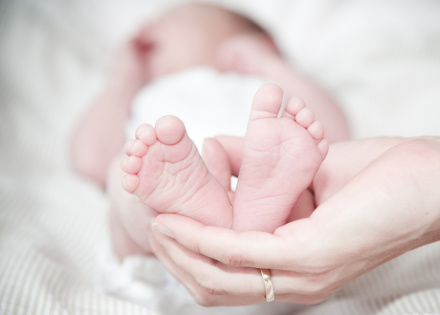
In Australia, a range of assessments are conducted to examine a baby’s hearing, weight, hips, and overall health. Parents have the opportunity to regularly connect with their local community nurse, engaging in conversations about concerns related to feeding, sleep, or any other matters.
Here are some of the developmental milestones for this age group as outlined in EYLF.
Physical
At 0-4 months, we expect to see the baby moving their whole body, eating, and sleeping patterns developing, startled when they hear a loud noise and turning their head to one side when their cheek is touched.
The baby makes sucking motions in response to hunger, responds to gentle touching, cuddling, and rocking, and shuts eyes tight in bright sunlight. They can typically lift their head and chest when lying on their stomach and initiate rolling from side to side. They typically start reaching to swipe at dangling objects and can grasp an object put into their hands, for example, grabbing your finger.
If there are delays in a few of these developmental areas, then a good first point of contact may be to check with your GP or community nurse.
Social
Under the social development area, babies in the 0-4 month range will start to smile, laugh, and make eye contact when within 20 cm from the face of an adult. They sleep most of the time and are fascinated with faces, including moving their head toward the sound of voices.
Emotional
The baby starts to bond with their primary caregivers, cries when hungry or uncomfortable, and usually stops when being held. They show excitement when a parent prepares to feed them.
Cognitive
We expect to see smiles and laughter as cognitive development progresses. Babies will look towards the direction of sound and may track a slow-moving target for a short period. They will look at patterns with light/dark contrast and faces. Babies copy adult tongue movements when being held or spoken to. They will repeat actions but are unaware of actions causing consequences.
Language
Babies cry to express their needs and make small throaty noises when content. They will be soothed by the sound of their caregiver’s voice or by low rhythmic sounds. They may start to mimic tongue movements from adults talking or copying sounds and will coo when content.
Here are some signs that the baby may need some development support:
● Not responding to sound / having difficulty hearing
● Unable to hold up head by the age of 4 months
● Unable to move both arms and legs
● When the parent talks or fusses at the baby, the baby doesn’t look at the caregiver or respond
● Does not show interest in people talking to them from a close distance
● Cries for a long time (more than 3 hours total in a day)
● Has an unusual cry (for example, high pitch)
Milestones 4-8 Months
During the 4-8 months old age range, we start to see babies show persistence, for example, practicing to sit up by themselves or making progress towards crawling movements. They are more attuned to others and can initiate simple interactions with other infants.
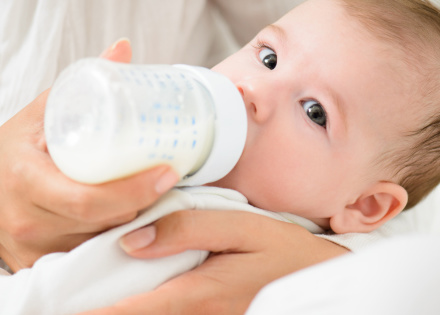
Physical
In addition to playing with their feet and toes, babies attempt to sit alone but require hand support. They can raise their head and chest when lying on their stomach and make crawling movements using both hands and feet. They can take weight on their feet while standing (or being held in a standing position). Among other skills, they can typically roll back to their stomachs, reach and grasp objects. They can smoothly follow an object or person, can watch activities from across the room and will turn their head to the sound of voices.
Social
Responds to attention or the approach of another baby or young child, to their name, smiles often and shows excitement seeing preparations for meals or bath time. As soon as they see familiar faces, they stretch out their arms to be picked up.
Emotional
The infant becomes more settled in eating and sleeping patterns, laughs, especially in social interactions and may self-soothe when tired or upset. They may begin to show the wariness of strangers and may fret when a parent leaves the room and are happy to see familiar faces.
Cognitive
At 4-8 months old, babies will usually swipe at dangling objects, shake, and stare at a toy placed in their hand, and become bored if left alone for long periods of time.
They will repeat accidentally caused actions that are interesting (for example, dropping objects from their highchair), enjoy games such as peek-a-boo or pat-a-cake and will search for partly hidden objects. In addition, a baby at this age is able to coordinate looking, hearing and touching, enjoy toys, banging objects, scrunching paper, exploring objects by looking at and mouthing them. Babies will also develop food preferences.
Language
Babies start to babble, respond with sounds when someone talks to them, or when they look in a mirror. They start to respond to their own name and enjoy games such as peek-a-boo, interacting with excited facial expressions.
The EYLF framework recommends that parents seek advice if the baby is not:
● Learning to make sounds
● Responsive to familiar faces or carers
● Learning to roll when on the floor
● Babbling and making sounds
● Playing with feet, swapping objects between hands
Milestones 8-12 Months
During the 8-12 months age range babies start to show more of their personality, developing interdependence, resilience, and more curiosity to explore the world around them.
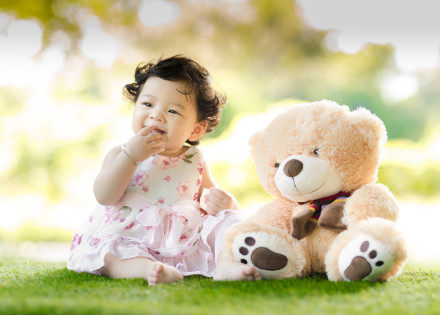
Physical
Babies start to pull themselves into a standing position when held and supported, or pull themselves up on a piece of furniture, they are able to sit up by themselves and without support. They are able to reach and stretch or move towards a toy that is out of reach, transfer objects from hand to hand and can use their thumb and finger to pick up small objects (pincer grip).
Many babies at this age will start to crawl, some may be able to stand up for a short period. They will attempt to hold a spoon to feed themselves, hold a piece of food or a bottle.
Social
At 8-12 months babies will start to show wariness around strangers and may watch and stare at unfamiliar faces. They continue to relate more to their peers, interacting by holding hands, passing objects, and babbling.
Emotional
Children at this age are developing autonomy and developing a strong sense of self, while seeking reassurance and support from their primary caregiver.
They show signs of stronger attachment to a parent or primary carer, showing signs of stress when a parent goes away. Other emotional observations may include offering toys but not releasing them, showing empathy when others are upset and actively playing and returning to a parent for reassurance and interaction.
Cognitive
It is at this age that they are starting to develop problem-solving skills (overcoming obstacles in order to reach a toy), as well as experimentation and testing in order to see what happens.
A child will start making gestures, understanding when a parent speaks to them, and noticing when things change.
Babies start to:
● Move objects to get to a toy
● Hit two objects together
● Drop toys out of their pram repeatedly in order for a parent to give it back to them.
● Knock over a tower of stackable cups
● Show interest in books, water play and sound-making toys
● Smile when they look in the mirror
Language
Babies will start to say words like ‘dada’ or ‘mama’ and mimic speaking sounds and tone as well as hand clapping.
Other language-based observations may include:
● Waving goodbye
● Enjoying finger rhymes
● Imitating actions and sounds
● Babbling tunefully
You may want to seek advice if baby is not:
● responsive to carers interactions including chats, songs, and games
● Babbling and making sounds
● Beginning to sit, crawl or pull themselves up to stand
● Playing with feet and swapping objects between hands
● Interested in holding toys
● Learning to eat food
Developmental Milestones for 1-2 Year Old’s
Through play, children learn about being part of a community, participating in activities with others, and developing their verbal and non-verbal communication skills.
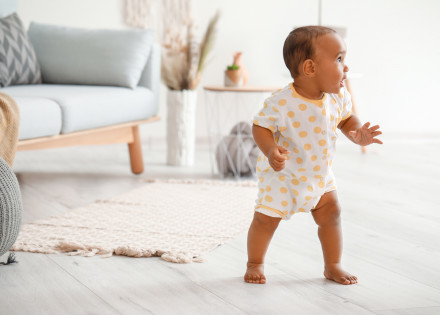
Physical
Between the ages of 1-2, children start to learn how to walk, climb, run, crawl, kick, and throw a ball. They will dance on the spot to music, often bouncing up and down, may revert to crawling if they are in a hurry to get somewhere and will experience frequent falls.
Other observations during this developmental phase include:
● Feeding themselves
● Can hold a crayon to draw scribbles on paper
● Turn pages of a book
● Squat to pick up objects
● Can drink from a cup
● Tries to use spoon and fork
Social
Infants may play alongside their peers, also known as parallel play, not interacting with each other. They show signs of cooperation when playing and require adult presence for reassurance.
Emotional
At this age children may show separation anxiety from their caregivers, for example during drop off at childcare. They start to watch for cues from parents regarding attitude to a stranger and may tantrum when tired or frustrated. In addition, they start to develop sympathy to others in distress, by patting, making noises, offering them solace, or offering an object.
Cognitive
Children can typically name body parts, point to objects when named and start to mimic household activities such as sweeping or vacuuming.
Other observations may include:
● Repeating actions that lead to interesting results such as banging a spoon on saucepan
● Recognise themselves in a mirror
● Spending a lot of time exploring and manipulating objects
● Stacks and knocks over items
● Chooses games and puts them away
● Calls self by name, uses ‘I’, ‘mine’, ‘I do it myself’
● Will search for hidden toys
Language
Children can say their own name and many words, beginning to use one to two word sentences for example., “Want milk”, mimic other toddlers and enjoying rhymes and songs.
EYLF framework recommends seeking advice if, toddlers between 1-2 are not:
● Using words or actions to communicate
● Wanting to move around
● Responding to others
● Seeking attention of familiar people
Developmental Milestones for 2-3 Year Old’s
Children at 2-3 years old start taking more responsibility for their physical needs (such as feeding themselves), play more with other children, become aware of fairness, build on their language skills, and start conversations with others.
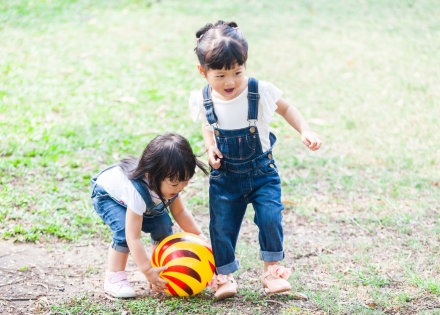
Physical
Physically, children at this age are much more confident when it comes to running, walking, climbing ,jumping and even attempting to balance on one foot. They are typically able to avoid obstacles, use steps one at a time, can squat and rise without using their hands, will walk into a ball to kick it and can catch a ball rolled to them.
Children at this age typically can:
● Move to music
● Holds a crayon with fingers
● Uses a pencil to draw circles and lines
● Gets dressed with help
● Self feeds using utensils and a cup
Social
At 2-3 children start to engage in basic make-believe play, they typically will begin to show a preference in the type of peers they wish to play and engage with and may find it hard to share toys forming a strong sense of ownership.
Emotional
Children may become more demanding of adult attention and grow a strong attachment to a parent, wanting this person to do things for them. They get upset when that person leaves for work or goes out without them.
Cognitive
Observations include ability to follow 2 or more directions, building a tower with 5-7 objects, lining up toys like a train, greater exploration of water play, sand, dough, symbolic play for example., fingers as people and an understanding of gender-role stereotypes.
Children typically start to count, identify genders, recognise differences and similarities, imitate rhythms and animal movements.
Language
Children’s vocabulary expands rapidly during 2-3 years, they are typically able to use 2 or 3 words together. For example., “want food now”, ask lots of questions and copy words and actions.
They can concentrate for longer periods to listen to stories, which greatly assists with the development of language. They enjoy making music, singing, and dancing.
● Is not interested in playing
● Is falling a lot
● Finds it hard to use small objects
● Cannot understand basic instructions
● Is not using many words or joining them in meaningful sentences
● Not interested in food
● Not interested in others
Developmental Milestones for 3-5 Year Old’s
As children get older they develop greater autonomy and responsibility, become more understanding of their peers, enjoy playing with other children, and learn skills to help them get along with others.
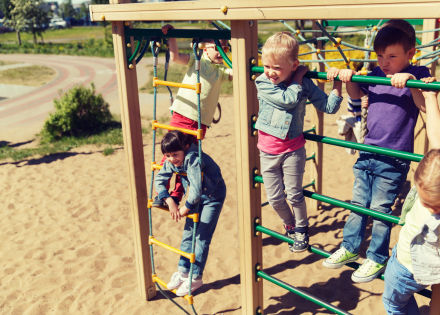
Physical
Children are typically able to get dressed with little help, go to the toilet by themselves and may start to toilet train at night.
They are typically able to:
● Hop, jump and run with ease (no more wobbling and less falls)
● Climb steps, alternating feet
● Gallop and skip leading with one foot
● Transfer weight to throw a ball
● Climb playground equipment more easily
● Hold a pencil in the correct grip, showing a hand preference
● Draws a variety of shapes
● Cuts paper with scissors
● Feeds themselves with minimal spills
Social
They enjoy playing with other children, learning how to share, take turns and cooperate with their peers. In this age group, children can take part in group activities and work together on a project, whether it’s art and craft, physical activity, or music.
It’s at this age that they are learning the foundations of social skills that they will need to form positive and meaningful friendships at school.
Emotional
Children have a stronger sense of who they are and their preferences of people they wish to play and spend time with. They may show occasional frustration with peers, show sympathy when someone gets hurt, become boastful and like to give and receive affection with parents.
Cognitive
At 3-5 children are able to process much more information, problem solve and use language to engage with others and build relationships.
Observations may include:
● Understanding opposites and positional words (start, end)
● Use objects and craft to build things (puzzles, towers, sandcastles)
● Answer simple questions
● Count 5-10 objects
● Self-talk to guide play
● Able to follow simple rules
● May start to write numbers and letters
● Dramatic play, pretending to be characters from a book or movie (for example)
● Able to recall events or tell a simple story
● Match and name some colours
Language
Children can typically have simple conversations, get curious and ask lots of questions (why?), they may talk non-stop and enjoy telling stories.
They are able to enjoy stories, rhymes and jokes and may assert themselves with words.
Parents may consider seeking advice if their child:
● Is not understood by others
● Stutters or has problems with speech
● Does not play with other children
● Can’t engage in a back-and-forth conversation
● No able to go to the toilet alone/ wash themselves
The EYLF framework offers insights into what we could anticipate in terms of child development during the initial five years. It’s worth noting that not all children will achieve every one of these milestones simultaneously, and occasional delays in one or two aspects need not raise undue worry.
If you find yourself concerned about your child’s progress in meeting any of these milestones, consider speaking with your GP, local nurse, or a pediatrician. If your child does need support, your health care practitioner will be able to refer you to an early intervention specialist or appropriate service.
